July 2015 LIP of the Month
How Trace Elements in Marine Pyrite can Track the Timing of Large Igneous Province Events
Ross Large, Department of Earth Sciences, University of Tasmania, Hobart, Tasmania, Australia. Ross.large@utas.edu.au
Introduction
For the last ten years I have been studying the trace element chemistry of pyrite using laser ablation ICP-MS. We have found that hydrothermal pyrite in ore deposits is commonly zoned in terms of trace element composition, which enables us to track the changes in composition of ore fluids through the paragenesis of an ore body (Large et al., 2009). Pyrite absorbs a range of trace elements from hydothermal fluids, including As, Ni, Co, Cu, Mn, Pb, Zn, Sb, V, Mo, Se, Ag, Bi, Au, Te, Sn, Tl, (in approximate order of concentration) and incorporates them into its structure during growth. Some elements that are stoichiometric in pyrite, particularly, Ni, Co, Se and Te are held tightly in the pyrite structure; other elements such as Mn, Mo, As, Sb, Ag, Au, Tl are more loosely held in the structure and easily rejected during pyrite recrystallisation. Copper, Zn and Pb commonly occur in pyrite as micro-inclusions of other sulfides. Gold, which has been the focus of much of our research (Large et al., 2007, Thomas et al., 2011) can occur in solid solution in the structure of pyrite, but also as native gold or electrum inclusions, or telluride inclusions, that range from nano to micro/macro scale.
Five years ago we had a change in research direction. I was sitting in a research seminar listening to one of my colleagues talk about the chemistry of the ancient oceans. He was discussing how a group of scientists in the USA had used computer models to predict the trace element chemistry of oceans 1 to 2 billion years old (Saito et al., 2003; Zirkle et al., 2005; Anbar, 2008). The idea gelled in my mind that we have the technology in our research laboratory to actually measure trace elements in the ancient oceans using the rock record; it was one of those rare light bulb moments that are few and far between. Rather than use computer models we could actually make the measurements. Based on our experience in using laser technology to track the history of trace elements in ancient ore fluids, the same technology should be able to be used to analyse sedimentary pyrites that formed on the ancient sea floor to track the chemistry of the oceans. The only problem was we would need to analyse many thousand sedimentary pyrites, from around the world in rocks ranging back to 3.5 billion years ago. That was when we formulated the TEO project – Trace Elements in the Oceans. Our aim was to track the changes in 22 trace elements in the oceans from 3.5 billion years ago to the present day; something that has never been done before. If we could do it, then it would have major implications, not only for understanding the formation of ore deposits on the ancient ocean floors, but also for understanding the evolution of life in the oceans. What we did not know, was that it would also tell us about the timing of major Large Igneous Province (LIP) events (Ernst, 2014) on Earth.
Trace Elements and Evolution
Scientist have known for some time that evolution of life in the oceans was strongly influenced by trace metal concentrations, as many metals (e.g., copper, zinc, manganese, vanadium, cobalt, molybdenum and selenium), are taken up by marine species and are critical for life and evolutionary change (Anbar, 2008). In fact up to 20 separate elements are required to maintain life and this is likely to have been the case through evolutionary history. In a recent book on ‘Evolution’s Destiny’ by two professors from the University of Oxford, Williams and Rickarby (2013) contend that evolutionary change, defined by Darwin as ‘random selection’, was far from random, and that chemical changes in the oceans controlled evolution and these changes are now fairly predictable.
Time Series Trends of Trace Elements (TE) in the Past oceans
The results of analysis of over 1800 marine pyrites in 131 marine black shales spread from Early Archean to the present day were eventually published in a proof of concept paper in Earth and Planetary Science Letters (Large et al., 2014). For the first time, twenty two TE time series curves were presented showing chemical change in the palaeo-oceans. The major conclusions of our research were that the concentrations of certain TE (Ni, Co, As, Cr) have generally decreased in the oceans through the Precambrian, other elements (Mo, Zn, Mn) have generally increased and a third group (Se, U, V) initially increased and then decreased.
There has been considerable debate of our work, however we have addressed the criticisms in the EPSL paper (Large et al., 2014) and are confident that the time series ocean TE curves based on the composition of marine pyrite are robust. The strength of our research is the quantity and quality of our data.
Nickel, Arsenic and Gold in the Oldest Oceans
One unexpected outcome from our research is that the oldest oceans from 3.5 to 2.5 billion years ago, contained enrichments in certain trace elements far more than the current oceans (Fig. 3). For example these oceans contained from 10 to 100 times more nickel, cobalt, arsenic, mercury and gold than the present oceans (Large et al, in press). In fact the arsenic and mercury levels alone would have made them toxic to marine life as we know it. However, bursts or pulses of nutrient trace elements such and Mo and Se were detected in our study of marine pyrite as far back as 3 billion years. These elements are both oxygen proxies and important for marine life, supporting other scientific studies that have shown evidence of single celled life and atmosphere oxygen pulses back to three billion years (Anbar et al., 2007; Crowe et al., 2013).
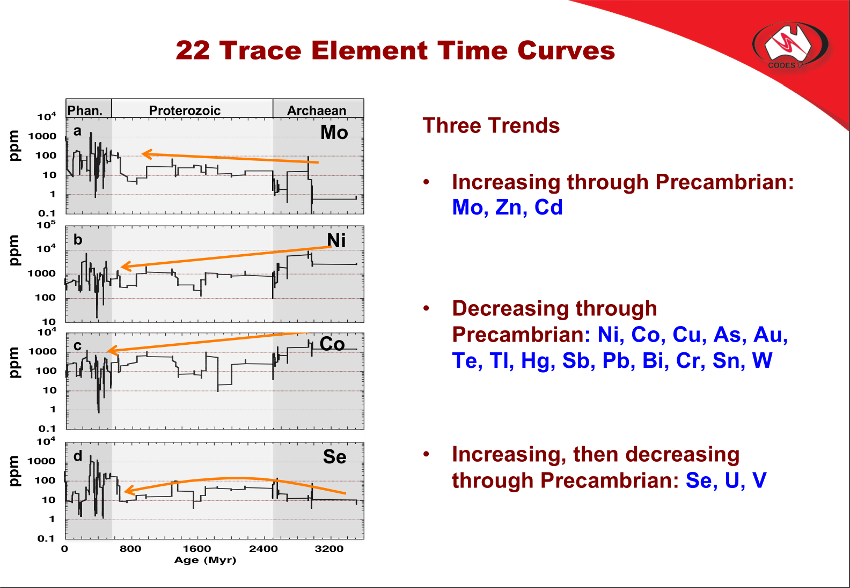
Figure 1: Time series curves for Mo, Ni, Co and Se in the past oceans based on the composition of marine pyrite. Three trends are apparent through the Precambrian. Rapid TE variations are revealed in the Phanerozoic that relate to evolutionary and tectonic trends and are discussed in Large et al. (2015).
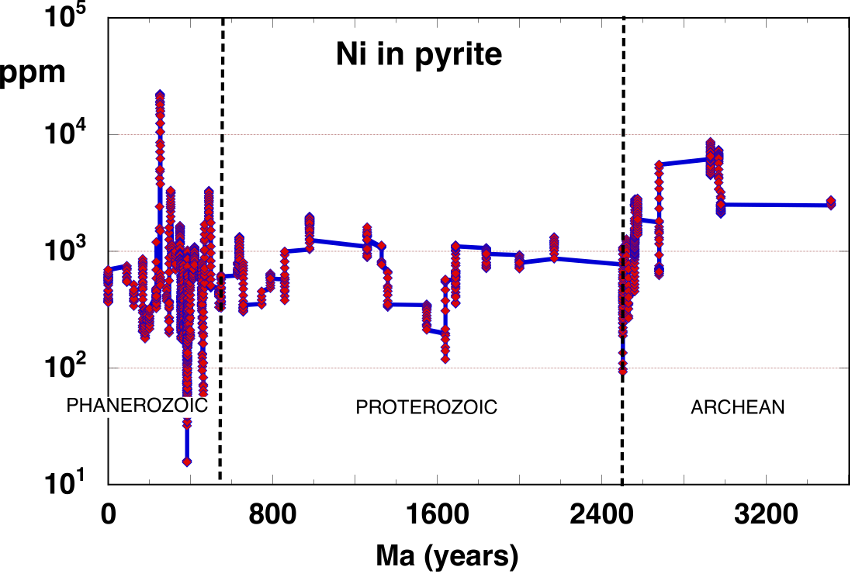
Figure 2: Time series plot for Ni in marine pyrite. Each red dot represents a pyrite spot analysis displayed as a 19 point rolling mean.
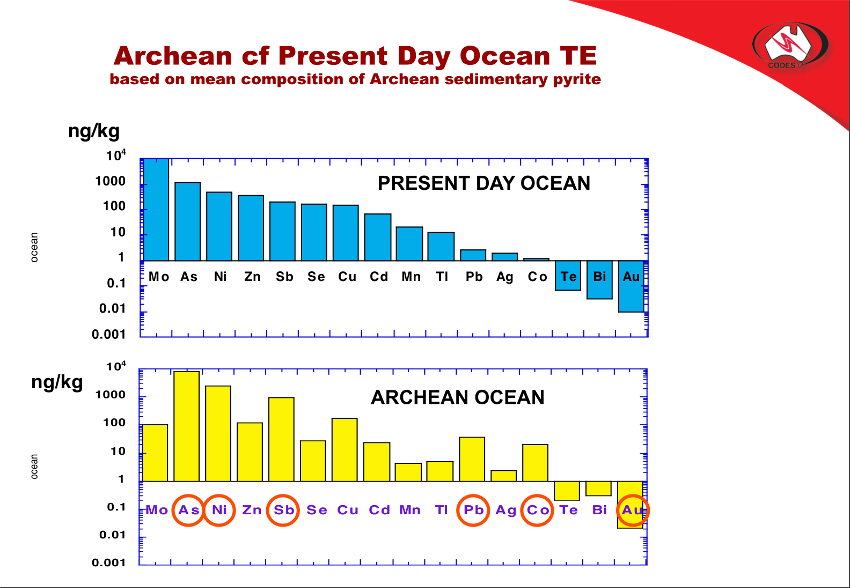
Figure 3: Comparison of TE composition of the modern ocean (Nozarki, 2010) with TE composition of mean Archean ocean based on LA-ICPMS analyses of Archean marine pyrite (Large et al., 2014). Note the relative higher levels of As, Ni, Sb, Pb, Co, Au and lower levels of Mo, Zn, Se, Cd and Mn in the Archean oceans.
Ni in Marine pyrite and Timing of LIPS
The elevated concentration of Ni in the Archean marine pyrite (Fig. 2), and by inference in the Archean ocean, is considered to be related to the prevalence of high magnesium basalts and nickeliferous komatiite LIPs over the period 2650 to 3050 Ma. Konhauser et al. (2007) reported a similar increase of the Ni/Fe ratio in banded iron formations over this period. Eruption and erosion of these mafic/ultramafics would have contributed significant quantities of particulate and soluble Ni into the Archean ocean, which was ultimately drawn down into marine pyrite in black shales and magnetite in BIFs (Large et al., 2014). Cobalt shows a similar pattern to Ni (Fig. 1c), but with more variation. The order of magnitude decrease in Ni and Co in marine pyrite around 2500 Ma and continuing into the Proterozoic, most likely relates to the decrease in komatiitic LIP activity.
Over the period from 3000 Ma to the present most of the segments of the time curves where Ni and Co in pyrite exceed 1000 ppm and 500 ppm respectively (Fig. 4), overlap with episodes of LIP eruptions of lavas and associated intrusives, both subareal and submarine (Prokoph et al. , 2004; Ernst, 2014).
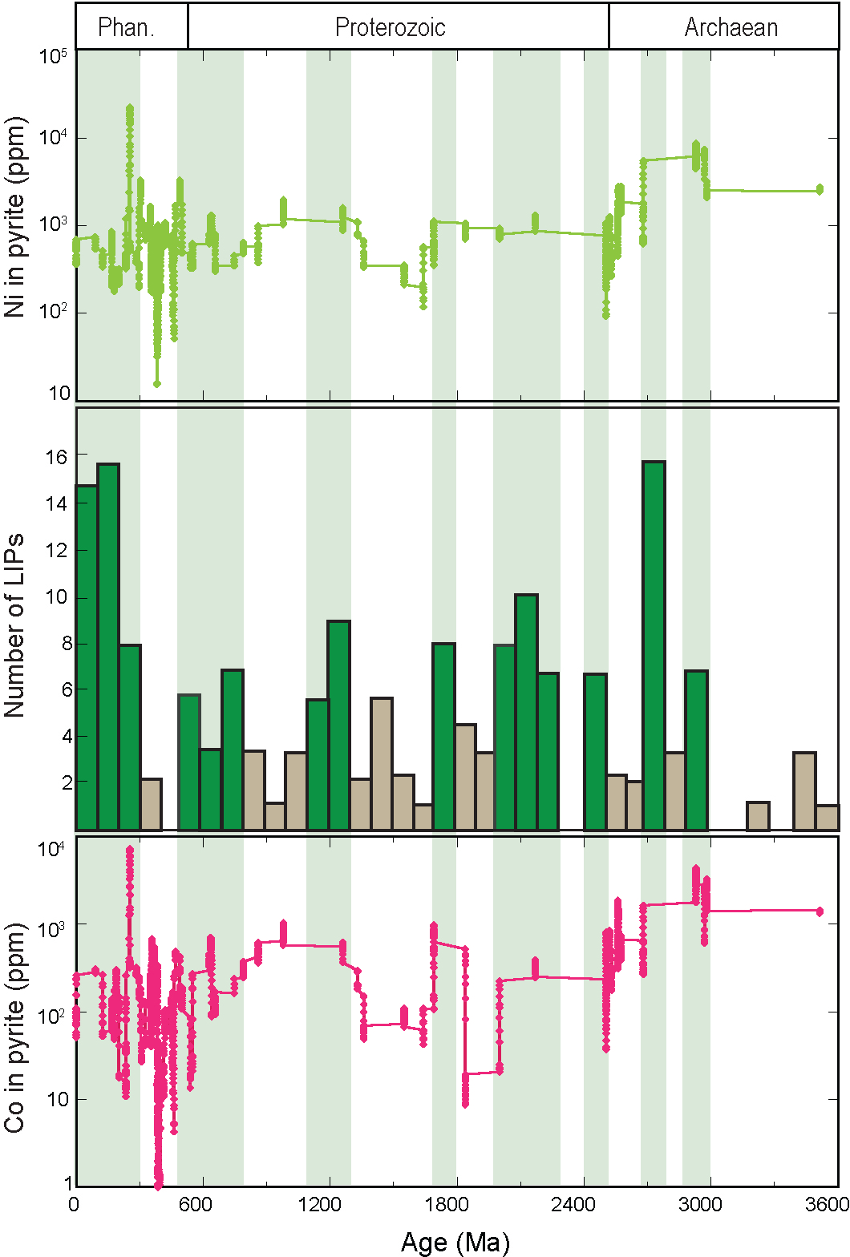
Figure 4: Correlation between LIP events (Prokoph et al. 2004) and Ni and Co time series curves for marine pyrite. The green periods of major LIP events generally correspond with elevated Co and Ni in marine pyrite, suggesting the global oceans were enriched in these elements due to the LIP events (Large et al., 2014).
The highest levels of Ni have been measured in marine pyrite at the Permian Triassic boundary (252 Ma) in the Perth Basin, Western Australia (Fig. 5). Concentrations up to 48,000 ppm Ni and 16,000 ppm Co have been recorded, indicating the likelihood of widespread enrichment of the global ocean in Ni and Co due to the Siberian Trap eruptions (Large et al., 2014). The correlation between LIPs and pyrite chemistry becomes obvious when it is recognized that one of the periods in Earth history of lowest LIP activity from 380 to 460 Ma records absolute minimum values of Ni and Co in marine pyrite (Fig. 5).
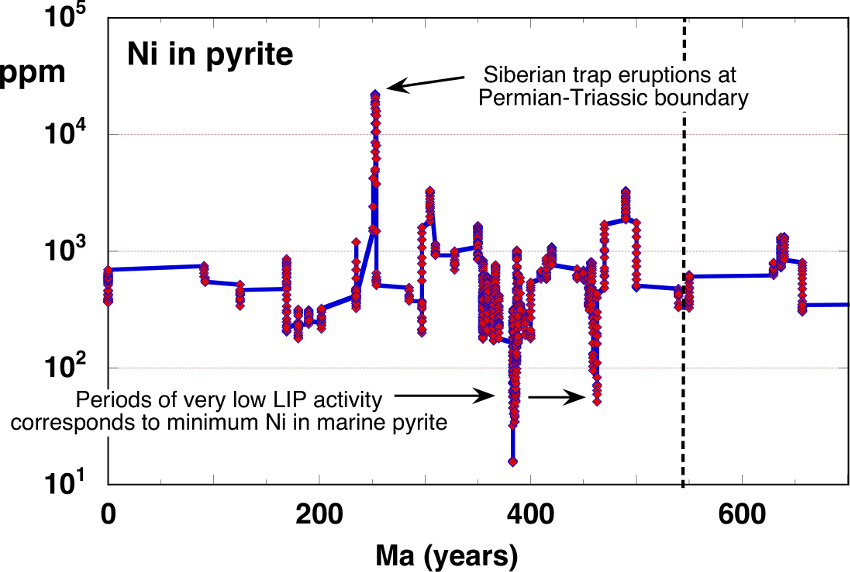
Figure 5: Ni measured in marine pyrite through the Phanerozoic. Each red dot represents a laser ICPMS spot analysis displayed as a 19 point rolling mean. The lack of pyrite data younger than 150 Ma has led to little correlation with the Late Mesozoic and Cenozoic LIP events.
Acknowledgements
I would like to thank the team of researchers who have worked on the TEO project and contributed to sample collection, analytical procedures, data interpretation and publication of results: Jacqueline Halpin, Leonid Danyushevsky, Elena Lounejeva, Valeriy Maslennikov, Daniel Gregory, Jeff Steadman, Peter McGoldrick, Timothy Lyons, Patrick Sack, Stuart Bull, Clive Calver, Sean Johnson, Charles Makoundi, Indrani Mukherjee, Peter Haines and Arthur Hickman. Thanks to Richard Ernst for encouraging me to write this piece for the LIP of the Month series.
References
Anbar, A.D., 2008. Oceans: Elements and evolution. Science 322, 1481-1483.
Anbar, A.D., Duan, Y., Lyons, T.W., Arnold, G.L., Kendall, B., Creaser, R.A., Kaufman, A.J., Gordon, G.W., Scott, C., Garvin, J., Buick, R., 2007. A whiff of oxygen before the great oxidation event? Science 317, 1903-1906.
Crowe, S.A., Døssing, L.N., Beukes, N.J., Bau, M., Kruger, S.J., Frei, R., Canfield, D.E., 2013. Atmospheric oxygenation three billion years ago. Nature 501, 535-538.
Ernst, R.E. 2014. Large Igneous Provinces. Cambridge University Press. 653 p.
Konhauser, K.O., Pecoits, E., Lalonde, S.V., Papineau, D., Nisbet, E.G., Barley, M.E., Arndt, N.T., Zahnle, K., Kamber, B.S., 2009. Oceanic nickel depletion and a methanogen famine before the Great Oxidation Event. Nature 458, 750-753.
Large, R.R., Danyushevsky, L., Hollit, C., Maslennikov, V., Meffre, S., Gilbert, S., Bull, S., Scott, R., Emsbo, P., Thomas, H., Singh, B., Foster, J., 2009. Gold and trace element zonation in pyrite using a laser imaging technique: Implications for the timing of gold in orogenic and Carlin-style sediment-hosted deposits. Economic Geology 104, 635-668.
Large, R.R., Halpin, J.A., Danyushevsky, L.V., Maslennikov, V.V., Bull, S.W., Long, J.A., Gregory, D.D., Lounejeva, E., Lyons, T.W., Sack, P.J., McGoldrick, P.J., Calver, C.R., 2014. Trace element content of sedimentary pyrite as a new proxy for deep-time ocean–atmosphere evolution. Earth and Planetary Science Letters 389, 209-220.
Large, R.R., Maslennikov, V.V., Robert, F., Danyushevsky, L.V., Chang, Z., 2007. Multistage sedimentary and metamorphic origin of pyrite and gold in the Giant Sukhoi Log deposit, Lena Gold Province, Russia. Economic Geology 102, 1233-1267.
Large R.R., Halpin, J.A., Lounejeva, E., Danyushevsky, L.V., Maslennikov, V.V., Gregory, D.G., Sack, P.J., Haines, P.W., Long, J.A., Makoundi, C. and Stepanov, S., 2015, Cycles of nutrient trace elements in the Phanerozoic ocean, Gondwana Research, doi: 10.1016/j.gr.2015.06.004
Large R.R., Gregory, D.G., Steadman, J. A., Tomkins, A. G., Lounejeva, E., Danyushevsky, L.V., Halpin, J.A., Maslennikov, V.V., Sack, P.J., Mukherjee, I. and Hickman, A., in press, Gold in the oceans through time. Earth and Planetary Science Letters, (2015).
Nozaki, Y., 2010. Elemental Distribution: Overview, In: Steele, J.H., Thorpe, S.A., Turekian, K.K. (Eds.), Marine Chemistry and Geochemistry: A Derivative of Encyclopedia of Ocean Sciences, 2nd Edition. Elsevier/Academic Press, Amsterdam, pp. 7-12.
Prokoph, A., Ernst, R.E., Buchan, K.L., 2004. Time-series analysis of large igneous provinces: 3500 Ma to present. Journal of Geology 112, 1-22.
Saito, M.A., Sigman, D.M., Morel, F.M.M., 2003. The bioinorganic chemistry of the ancient ocean: The co-evolution of cyanobacterial metal requirements and biogeochemical cycles at the Archean-Proterozoic boundary? Inorganica Chimica Acta 356, 308-318.
Thomas, H.V., Large R.R., Bull S.W., Maslennikov, V.V., Berry, R.F., Fraser, R., Froud, S. and Moye, R., 2011, Pyrite and Pyrrhotite Textures and Composition in Sediments, Laminated Quartz Veins, and reefs at Bendigo gold mine, Australia: insights for ore genesis: Economic Geology, v 106, p. 1-31.
Williams, R.J.P., Rickaby, R.E.M., 2012. Evolution's Destiny: Co-evolving Chemistry of the Environment and Life. The Royal Society of Chemistry, Cambridge.
Zerkle, A.L., House, C.H., Brantley, S.L., 2005. Biogeochemical signatures through time as inferred from whole microbial genomes. American Journal of Science 305, 467-502.